
In the second of the series covering the history of Cornish pubs and ale houses, Chris Knight provides an interesting insight into the role played by the White Hart Hotel in the development of St Austell.
“Thence I went over the heath to St Austins wch is a Little market town where I Lay, but their houses are like Barnes up to ye top of ye house. Here was a pretty good dineing room and Chamber within it and very neate Country women. My Landlady brought me one of ye west Country tarts this was ye first I met wth though I had asked for them in many places in Sommerset and Devonshire; its an apple pye wth a Custard all on the top, its ye most acceptable entertainment yt Could be made me. They scald their Creame and milk in most parts of those Countrys and so its a sort of Clouted Creame as we Call it, wth a Little sugar and soe put on ye top of ye apple Pye. I was much pleased wth my supper.”
Through England on a side saddle in the time of William and Mary, the diary of Celia Fiennes. C. 1695.
Clouded though this account may be by the misspellings of a different age, there is little doubt that Celia Fiennes, that intrepid 17th century English adventuress, was referring to St Austell in this passage and that, as one of the oldest inns of the town, situated as it originally was at its heart in Fore Street, the ‘good dineing room and chamber’ was most probably furnished by the White Hart. The history of this fine old establishment is inextricably entwined with that of the town which grew around it and even more so with some of the key entrepreneurial figures connected with the town; Charles Rashleigh, who developed the port of Charlestown and Walter Hicks, founder of St Austell Brewery.
As with most Cornish towns, St Austell’s position within an important mining area, which included the Polgooth, Great Hewas and massive open cast Carclaze pit works, dramatically changed the nature of the town. Pococke referred to St Austell in 1750 as ‘a little tinning town’ but by 1788 the Reverend Shaw could nominate it the ‘Peru of Britain’ because of the amount of mining-related business being undertaken there. As the town grew, so too did the White Hart as its foremost inn, referenced in Fore Street in 1735, it continued to ply its trade to a growing number of travellers. No doubt these numbers would have increased dramatically when the first turnpike through the town, linking up to the main Plymouth to Truro road, appeared directly outside its doorstep in 1760.
In 1799, the old inn received glowing praise by one literary traveler – Lipscomb, who described it as “the best in Cornwall and the cheapest we had met with on our journey”.
“I should be wanting,” he adds, “in my duty to all my travelling readers did I not strongly recommend the White Hart at St. Austell to their favour.”
The landlords must have carried on its successful trading as, by 1824, it was pronounced “an excellent house for commercial gentlemen.” by F.W.L.Stockdale on his own peregrination into Cornwall. However, by this time, the old White Hart was no longer, and Stockdale’s comments must have been passed on to the much grander establishment around the corner in Church Street to which the White Hart’s licence had been transferred just a few years earlier and where the present White Hart Hotel still presides. Built in 1769 with an imposing granite façade just opposite the church, this edifice was formerly the town house of the aforementioned Charles Rashleigh, local dignitary and mining entrepreneur.
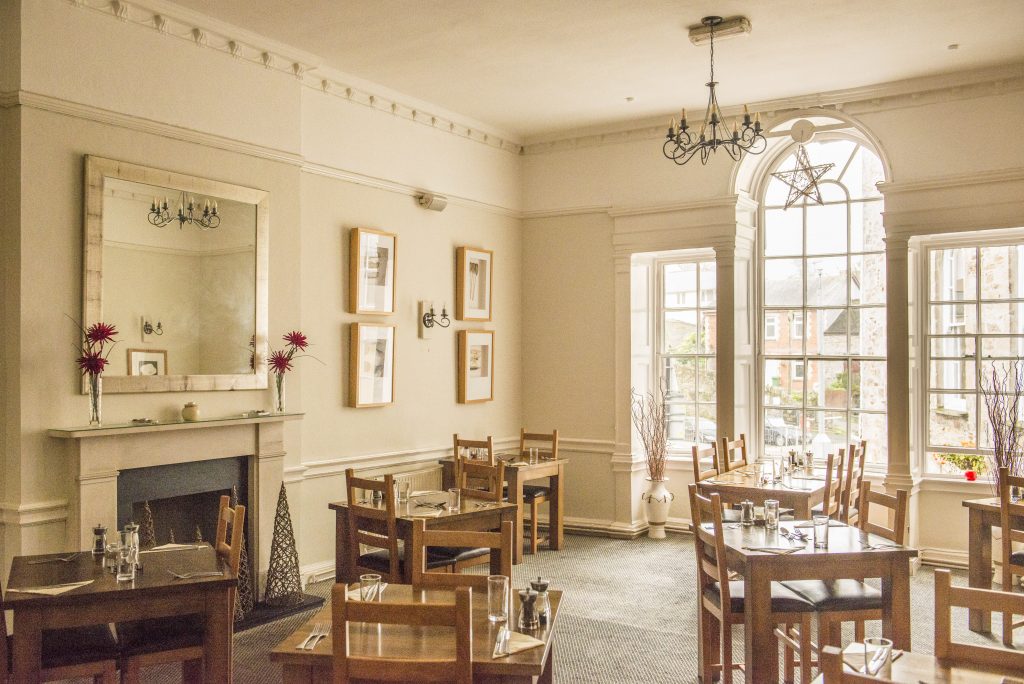
At a time when many of Cornwall’s various mining ventures were beginning to wane, St Austell’s fate was destined to be a little different to that of its fellow industrial centres. At least for a while, following the discovery in 1746 of Kaolin, or china clay, in the hills around the town. By 1782, the clay trade was in full swing following the establishment of the Cornwall Clay Company by Josiah Wedgwood and John Carthew. As growth of exports of china clay expanded rapidly, a new and safe harbour was required to transport this precious cargo out of Cornwall and overseas. As a result, between 1791 and 1795, the port of Charlestown was constructed and a busy route established along Church Street and up the old East Hill as the clay wagons forged their way to the waiting ships.
When Charles Rashleigh retired from business and the town in the early 1820s, it didn’t take long for his sharp, commercially-oriented mind to consider the benefits of opening up a hostelry along this busy thoroughfare so that as the heart of St Austell shifted on its axis to embrace the growing clay trade, the town house became a public house and the White Hart yet again found itself at the centre of the new town dynamics. The earliest reference to the new White Hart Hotel shows the landlady as one Elizabeth Price in 1830 and, as alluded to by Mr Stockwell, it fast became the favourite stopping point for the ever-increasing number of commercial travellers, eager to hawk their wares to the retailers and tradesmen in this newly invigorated local economy. As the nineteenth century progressed, the inn passed from family to family as a well-presented inn and posting house, run consecutively by the Lynns in the 1840s, the Dunns in the 1850s and 1860s, the Gregory family in the 1870s, the Lukes between 1883 and 1902 and the Tootells from 1902 to around 1908.
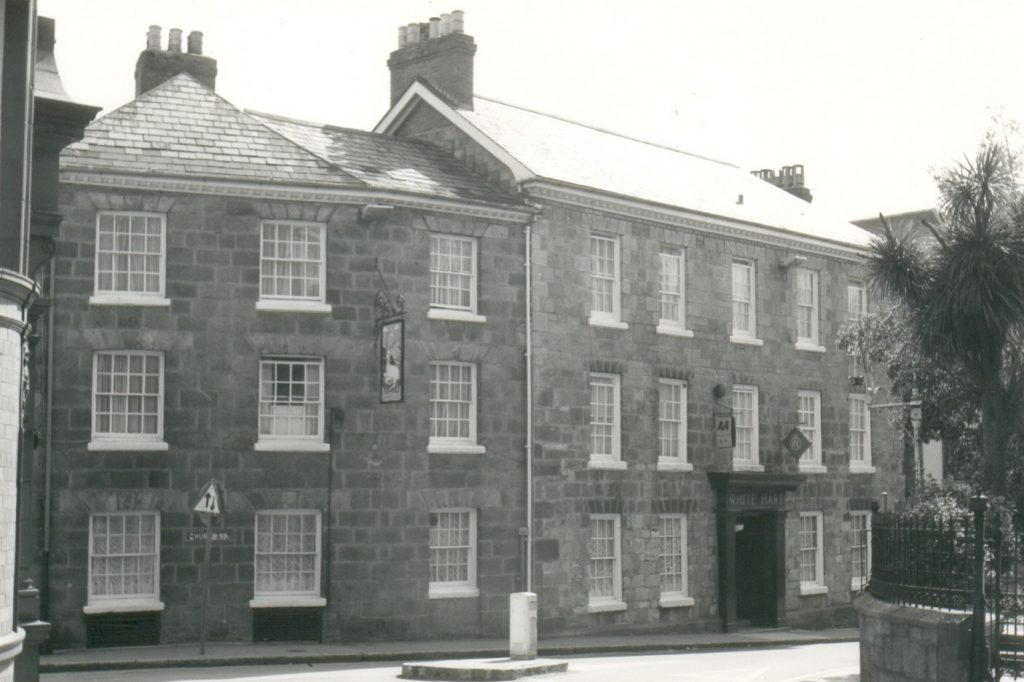
The success of the hotel was not simply one of location. While the building was fair to behold externally, by all accounts this was more than matched by the internal décor that met clients as they were swept into the grand atrium through the stylish revolving doorway. Discovered during a refurbishment in the 1930s, attached to the dining room walls were a series of extremely rare woodcut wallpaper sheets, designed and created by Joseph Dufour and Company of Paris and hung in around 1822 when the new White Hart was opened. Removed painstakingly by professionals from the British Museum, the sheets were donated by the then owners of the hotel, St Austell Brewery and they are now kept at the Victoria & Albert museum, a reminder of the incredible prosperity and spending power available to those early traders in Cornish ‘white gold’.
As is all too obvious to the modern eye, the halcyon days of the china clay industry are well behind us, even though the remnants of the industry remain as an all-too clear reminder of its previous scale. Over time, St Austell has suffered a similar, if somewhat belated, fate to those other Cornish industrial centres as the mainstay of their economies went into decline. However, that is by no means the end of the White Hart story as its fortunes became entwined with yet another local legend in the form of Walter Hicks. Back in 1851, this young entrepreneur – forced out of the family home at the age of 7 when it was put into trust and rented out for him on his father’s death – mortgaged his inheritance as soon as he came of age and set up in business as a merchant and importer of wines and spirits in Church Street, just four doors down from the White Hart Hotel.
As the son of a country yeoman, young Walter was keen to make his mark on the town as soon as he could and though his first step might at first glance seem a strange one, by enrolling as a member of the town’s Bowling Club, he was in fact joining an elite set of the great and good of the town, including the Rashleighs, well-known architects Silvanus Trevail and Barrett, Councillors Wheeler-Higman and Nicholls and a host of other town dignitaries. Through hard work, dedication and making the right connections, Walter Hicks was able to drive out pretty much all of his opposition in the wine and spirits trade in the town, including his cousin George Andrew, by 1858.
The business was made all the more viable when the Great Western Railway crashed into Cornwall across Brunel’s 1859 bridge linking Cornwall’s existing rail network to the rest of the country and it is interesting to note that while the railway brought cheaper imports, new opportunities and visitors into Cornwall, it also dealt a major blow to the prosperity of small harbours such as Charlestown which had previously held a monopoly on the transport of heavy goods and cargo in and out of the county. Yet again the dynamics of St Austell were changing. Seizing the opportunities made available to him with a firm hand, Walter Hicks branched out into the brewing business in 1863 with the purchase of his first pub, the Seven Stars, literally a stone’s throw away from the White Hart. Having mortgaged everything to set up his business, the purchase of the lease, at £500, was made possible by an inheritance from his wife’s aunt Hester.
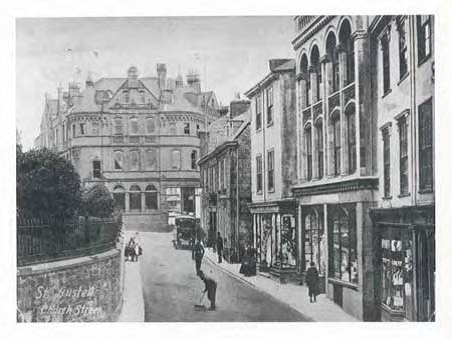
While ownership of St Austell’s flagship hotel may well have been at the top of Walters wish-list, it was no doubt beyond his spending power at this stage. However, with acute business-sense, Walter already had a plan that would elevate him above the run of the mill brewing operations and brew-houses that proliferated in St Austell as they did in other towns across the county. Through careful investment and building up of his business, in 1870 Walter was able to acquire the freehold on another old St Austell hostelry – the London Inn, within which he built one of the county’s first and finest Victorian steam breweries, a building which still exists in the town today as Tregonissey House.
Just a two-minute cart ride away from the new mainline station, Walter was able to make extensive use of this new network to ferry St Austell Ales into almost every nook and cranny of Cornwall. A swift glance at the development of the St Austell Brewery estate is testament to Walter’s quick wittedness, making use of the railway to bring his wares to the major towns and then buying up wine and sprit businesses in those towns to act as depots from where his shire-pulled drays and later steam and petrol fleet could take the ale to the more rural and hard to reach communities. Nankivell’s of Truro, Pool’s of Penzance, Coombe’s of Wadebridge and Huxtable’s of Newquay are just a few of the acquisitions that allowed him to branch out in this way to supply his ever –expanding estate of country and seaside inns and hotels.
By 1890, Walter Hicks had outgrown his town-based brewery and had moved up the road into a newly erected, state-of-the-art brewery in Trevarthian Road with more than triple the capacity of his old headquarters. It was still within easy access of the station, but now also within striking distance of the newly improved road system to the north and east. However, even with his eyes on prizes beyond the bounds of Cornwall, Walter Hicks was still a local man at heart and his desire to win the respect and acceptance of his contemporaries led to him becoming president of the town board of trade and purchasing Brake House, the former home of the prosperous Martyn china clay dynasty and one of the most desirable properties in the neighbourhood, a sign perhaps of the changing fortunes within the town.
As for the White Hart, Walter made his first bid for the town’s flagship hotel when it went to auction in 1908 but considered the reserve of over £4000 to be too high, leaving the house unsold and in the hands of the existing landlord, Mr G. Wroe. However, a royal visit to the town and hotel by His Majesty King Edward VII in 1909 may well have persuaded Walter of its worth as he paid an extra £1000 above that reserve when he finally added it to his empire in 1911.
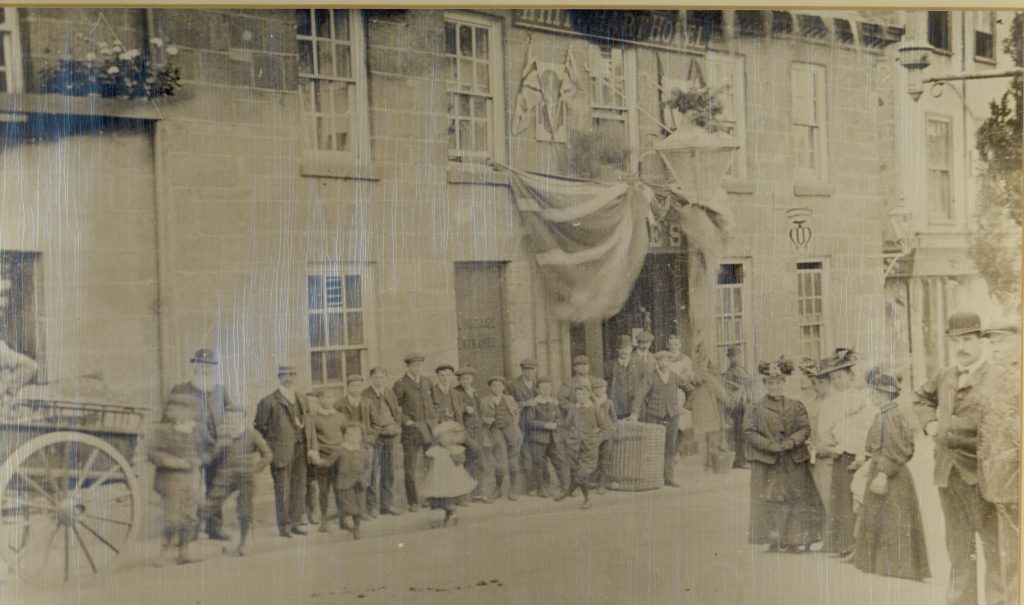
His first action as the new owner was to drive down another thriving business within the town. In 1912, the licence for the White Hart had come up for renewal at the St Austell Licensing Sessions, but had come close to being revoked as its notorious tap room, at the back of the hotel, was reported in the St Austell Star newspaper as being ‘a habitual resort of prostitutes.’ By 1913, Borough council records show that plans for alterations to the tap room making it more easily monitored by hotel staff had been submitted by Walter Hicks, accepted and the work carried out.
By 1925, the business was flourishing to such an extent that a whole new storey was added to the hotel by Walter’s daughter, Hester Parnall who had taken over the running of the business at his death in 1916, MD of a brewing business at a time when women did not even have the right to vote. In the 1940s, the St Austell Brewery MD Egbert Barnes, Walter’s grandson, used the White Hart as a cultural centrepiece to display works of art produced by local artists of note, especially those from the St Ives area such as Borlase Smart, Ben Nicholson, and his wife the famous sculptor Barbara Hepworth. In 1946, Egbert even purchased two of Nicholson’s paintings for the Brewery for £50 and £30, much to the ‘pained surprise’ of his colleagues. Seventeen years later, they were sold at Sotheby’s for £2350 and the proceeds paid for the entire refurbishment of the Hotel.
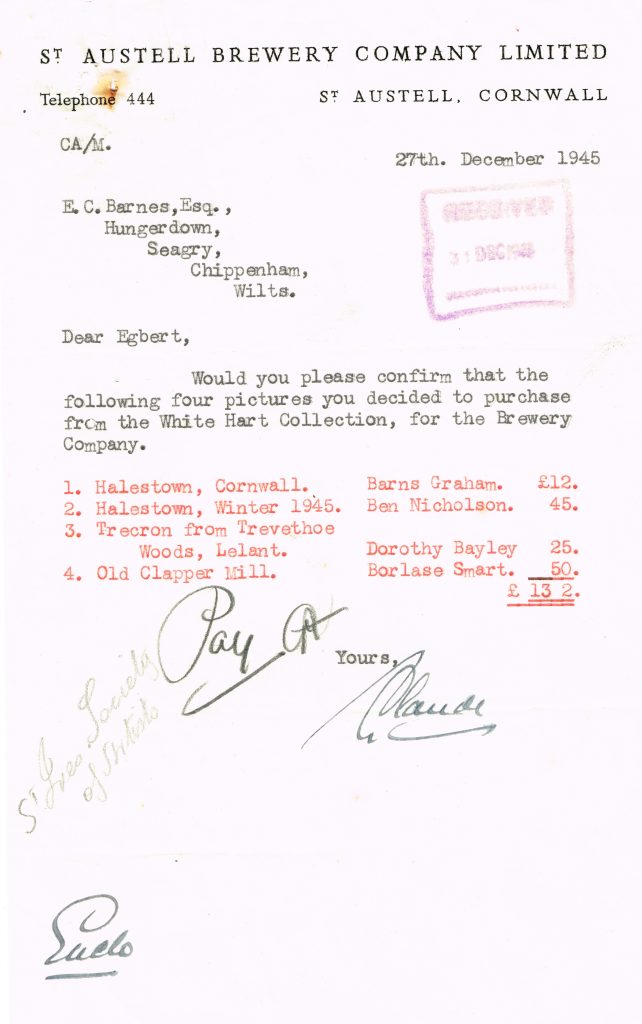
The White Hart continues to sit at the centre of the ever-expanding St Austell Brewery estate, having served recently as a training centre of excellence within the burgeoning hospitality trade, an industry which has become synonymous with modern Cornwall. While not pretending to be able to match the prosperity nor levels of employment produced by the mining industries of the past, the Brewery is now a cornerstone of the Cornish economy and, most likely, a much nicer place to work than down the mines.
Times definitely change, cultures too, and while the Cornwall of today is a very different place to its nineteenth century counterpart with the diaspora of Cornish miners around the world replaced by a flood of incomers and second homers drawn by the sun and the surf, the survival of the White Hart in its modern guise as a popular, town-centre boutique hotel is extremely important in terms of the cohesion and heritage of the town as well as a reminder of its more colourful past.
You can find part one in the series, a brief history of the Hawkins Arms in Probus here.
